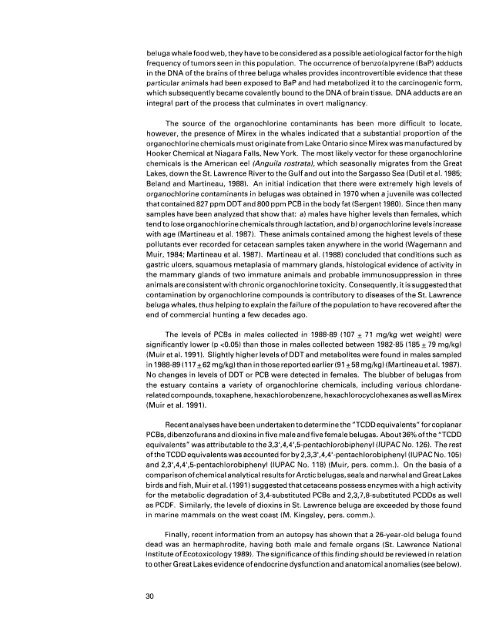International Joint Commission
International Joint Commission
International Joint Commission
Create successful ePaper yourself
Turn your PDF publications into a flip-book with our unique Google optimized e-Paper software.
elugawhalefood web, they haveto beconsidered asa possible aetiologicalfactorforthe high<br />
frequency of tumors seen in this population. The occurrence of benzo(a)pyrene (BaP) adducts<br />
in the DNA of the brains of three beluga whales provides incontrovertible evidence that these<br />
particular animals had been exposed to BaP and had metabolized it to the carcinogenic form,<br />
which subsequently became covalently bound to the DNA of brain tissue. DNAadducts are an<br />
integral part of the process that culminates in overt malignancy.<br />
The source of the organochlorine contaminants has been more difficult to locate,<br />
however, the presence of Mirex in the whales indicated that a substantial proportion of the<br />
organochlorinechemicals must originate from Lake Ontario since Mirex was manufactured by<br />
Hooker Chemical at Niagara Falls, New York. The most likely vector for these organochlorine<br />
chemicals is the American eel (Anguila rostrata), which seasonally migrates from the Great<br />
Lakes, down the St. Lawrence Riverto the Gulf and out into the Sargasso Sea (Dutil et al. 1985;<br />
Beland and Martineau, 1988). An initial indication that there were extremely high levels of<br />
organochlorine contaminants in belugas was obtained in 1970 when a juvenile was collected<br />
that contained 827 ppm DDTand 800 ppm PCB in the body fat (Sergent 1980). Since then many<br />
samples have been analyzed that show that: a) males have higher levels than females, which<br />
tend to lose organochlorinechemicalsthrough lactation, and b) organochlorine levels increase<br />
with age (Martineau et al. 1987). These animals contained among the highest levels of these<br />
pollutants ever recorded for cetacean samples taken anywhere in the world (Wagemann and<br />
Muir, 1984; Martineau et al. 1987). Martineau et al. (1988) concluded that conditions such as<br />
gastric ulcers, squamous metaplasia of mammary glands, histological evidence of activity in<br />
the mammary glands of two immature animals and probable immunosuppression in three<br />
animals are consistentwith chronic organochlorine toxicity. Consequently, it issuggested that<br />
contamination by organochlorine compounds is contributory to diseases of the St. Lawrence<br />
beluga whales, thus helping to explain the failure of the population to have recovered after the<br />
end of commercial hunting a few decades ago.<br />
The levels of PCBs in males collected in 1988-89 (107 71 mg/kg wet weight) were<br />
significantly lower (p

















